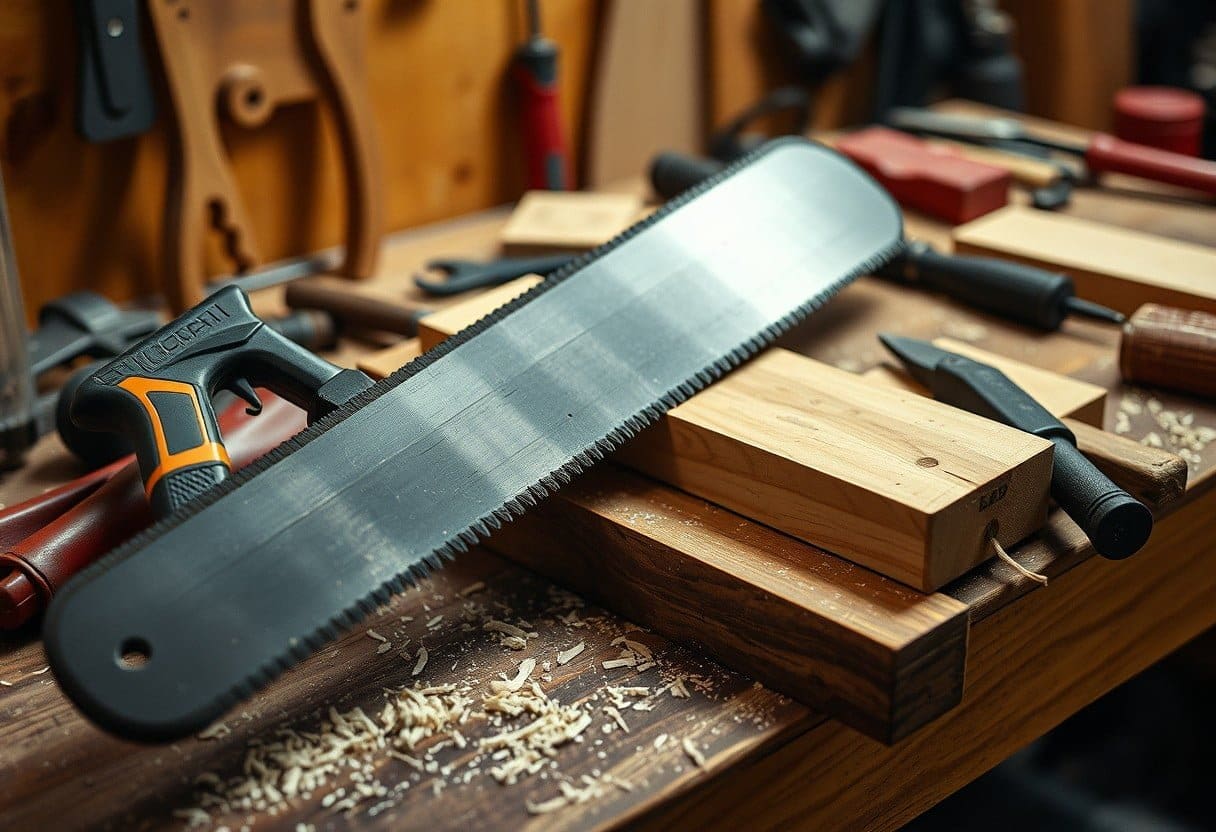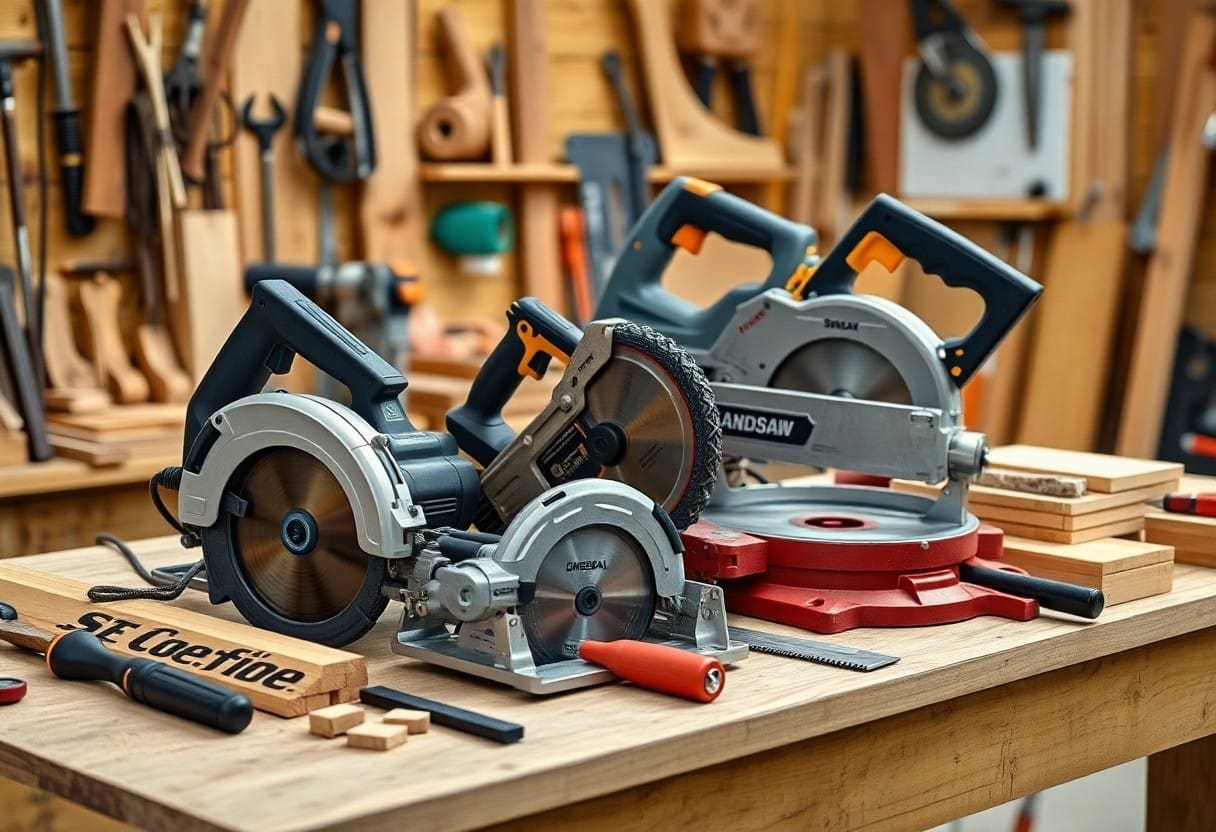This guide will explore the critical importance of investing in a high-quality saw for your craftsmanship. Whether you’re a seasoned professional or an enthusiastic hobbyist, having the right saw can elevate your projects from mediocre to exceptional. You’ll discover how the precision, durability, and efficiency of a premium saw can not only enhance your workmanship but also save you time and effort in the long run. Let’s investigate why this necessary tool deserves a prominent place in your workshop.
Types of Saws
A comprehensive understanding of different saw types can significantly enhance your craftsmanship. Here’s a quick overview of common saw types:
| Saw Type | Usage |
|---|---|
| Hand Saw | Manual cutting for simple tasks |
| Power Saw | Efficient and precise cuts |
| Band Saw | Circular cuts in various materials |
| Circular Saw | Rapid and straight cuts in wood |
| Specialty Saw | Used for specific applications |
This knowledge empowers you to select the right tool for your craftsmanship needs.
Hand Saws
Saws classified as hand saws are fundamental tools in your workshop. They come in various shapes and sizes and are ideal for making straightforward cuts in wood without needing electricity. Using a hand saw can enhance your control over the cut, allowing for precision in small, detailed projects.
Power Saws
Some of the most versatile tools in your arsenal, power saws drastically increase efficiency and accuracy in your woodworking projects. These saws come in various forms, including miter saws, table saws, and jigsaws, allowing you to tackle virtually any cutting task with ease and speed.
Plus, with the ability to handle larger materials and thicker woods, power saws cut down on labor time while providing cleaner edges and more complex shapes. The energy behind these tools minimizes fatigue, ensuring you can work longer with fewer interruptions.
Specialty Saws
On the other hand, specialty saws cater to unique cutting needs that general saws may not fulfill. These include items such as tile saws, coping saws, and scroll saws. Their specialized features enable you to perform intricate cuts and specialized tasks that would otherwise be challenging with standard tools.
This tailored approach allows you to expand your capabilities and take on diverse projects with confidence and creativity, ensuring you achieve the best results every time.
Factors to Consider When Choosing a Saw
It’s important to evaluate several factors when selecting a saw to ensure it meets your specific needs. Consider the following:
- Type of projects you undertake
- Material you will be cutting
- Frequency of use
- Ergonomics and ease of handling
- Your budget
Assume that making an informed choice will enhance your woodworking efficiency and satisfaction.
Material and Durability
For ultimate performance and longevity, choosing a saw made from high-quality materials is vital. Premium materials resist wear and maintain sharpness, allowing for cleaner cuts.
Blade Types and Sizes
Some key considerations for blade types and sizes include:
- Tooth count
- Thickness of the blade
- Blade material (carbide, steel, etc.)
- Type of cuts desired (crosscut, rip, etc.)
- Compatibility with your saw model
Perceiving the right blade type and size is important for optimizing your cutting performance.
| Blade Type | Best For |
| Crosscut | Woodworking |
| Rip | Long cuts along the grain |
| Combination | Versatile tasks |
| Carbide-tipped | Durability and longevity |
Consider your project requirements when selecting a blade size and type, as these variables significantly affect the outcome of your work.
- Thickness for smoother cuts
- Length for maximum reach
- Type of teeth for different fineness of cuts
- Diameter for power and stability
- Material compatibility with the saw
Perceiving the importance of these factors will ensure your projects are successful.
Safety Features
Blade safety should always be a priority when choosing a saw. Ensure that the model you consider has important safety options to protect you during operation.
Factors such as blade guards, anti-kickback features, and emergency shut-off mechanisms are integral components of a safe saw. Investing in these safety features minimizes the risk of accidents and injuries while you work, allowing you to focus on crafting with confidence.
Tips for Maintaining Your Saw
All craftsmen understand the importance of maintaining their tools for optimal performance. To keep your saw in excellent condition, consider the following tips:
- Clean your saw after each use to remove debris.
- Store it in a dry, secure location.
- Regularly sharpen the blade to ensure efficient cutting.
- Check and tighten loose parts before use.
Any oversight can lead to decreased performance and a shorter lifespan for your saw.
Cleaning and Storage
Now, proper cleaning and storage are vital for your saw’s longevity. After each use, wipe down the blade and body to eliminate dust and sap, preventing build-up that can hinder performance. Ensure your saw is stored in a dry, secure place to avoid rust and damage from environmental factors. Using a protective case or cover when not in use can further enhance its lifespan.
Regular Sharpening
With regular sharpening, you can significantly enhance your saw’s cutting efficiency. Dull blades not only make your work harder but can also pose safety risks. Invest time in sharpening your saw at least every few uses or when you notice a decrease in performance. By maintaining a sharp edge, you’ll ensure smoother cuts and prolong the life of your tool.
Cleaning the blade of your saw before sharpening ensures that debris doesn’t interfere with the process. You can use a dedicated sharpening file or an electric sharpener for precision. Be sure to maintain the original angle of the blade while sharpening, as this will contribute to better cutting performance and prevent damage.
Proper Usage Techniques
Maintaining proper usage techniques is crucial for effective cuts and saw longevity. Always follow the manufacturer’s guidelines for your specific saw type, and adopt a firm grip while cutting to ensure stability. Additionally, using the right cutting speed and force can prevent wood from pinching the blade, while also reducing wear on the tool.
Sharpening techniques play a key role in your saw’s performance. Always use the appropriate tools for sharpening, such as files or whetstones designed for the specific type of blade you have. Pay attention to the tooth profile and make sure you are sharpening in the correct direction to achieve the best results, yielding clean and precise cuts for all your projects.
Step-by-Step Guide to Selecting the Right Saw
Despite the vast array of saws available, selecting the right one requires careful consideration and a structured approach. With various types, sizes, and functionalities, understanding your particular needs is crucial. Follow these steps to ensure your choice aligns with your craftsmanship goals:
| Step | Guideline |
|---|---|
| 1 | Assess your craftsmanship needs |
| 2 | Compare features and specifications |
| 3 | Make an informed purchase |
Assessing Your Craftsmanship Needs
The first step is to evaluate the specific tasks you intend to accomplish with your saw. Consider the types of materials you’ll be cutting, the precision required, and the scale of your projects. Different saws excel in different applications, so identifying your primary use cases will help narrow your options significantly.
Comparing Features and Specifications
Little nuances can greatly impact your woodworking experience, from tooth count to blade material. Here’s how some key features stack up:
| Feature | Consideration |
|---|---|
| Blade Length | Impacts cut capacity and depth |
| Tooth Count | Affects finish quality and speed |
| Power Source | Corded vs. cordless for mobility |
Assessing these features enables you to prioritize what matters most for your projects. For instance, a higher tooth count is ideal for fine cuts, while a more robust power source suits heavy-duty work. Think about your typical tasks to guide your feature selection.
| Specification | Importance |
|---|---|
| Weight | Affects handling and fatigue |
| Ergonomics | Impact on user comfort |
| Price | Must fit within your budget |
Making an Informed Purchase
With a definitive list of your needs and features in mind, it’s time to make an informed purchase. Evaluate various products, read user reviews, and compare prices to ensure you choose a saw that offers the best value for your craftsmanship journey.
Your final selection should blend quality, functionality, and affordability. Don’t rush this decision; a high-quality saw can be an invaluable asset in your toolkit, enhancing not only your projects but also your overall woodworking experience. Take the time to weigh your options carefully, and invest in a tool that will serve you well for years to come.
Pros and Cons of Different Saw Types
For every craftsman, understanding the pros and cons of various saw types is crucial for choosing the right tool for specific projects. Below is a breakdown highlighting some of the primary advantages and disadvantages.
| Type of Saw | Pros and Cons |
|---|---|
| Hand Saw | Pros: Portable, no electricity needed Cons: Requires physical effort |
| Circular Saw | Pros: Fast cuts, versatile Cons: Can be heavy, safety risks |
| Table Saw | Pros: Precision cuts, stable Cons: Space-consuming, costly |
| Jigsaw | Pros: Intricate cuts, portable Cons: Limited cutting depth |
| Band Saw | Pros: Curved cuts, smooth finish Cons: Bulky, requires setup |
Advantages of Hand Saws
Clearly, hand saws offer unique advantages such as portability and independence from power sources, making them ideal for on-the-move tasks. Additionally, they allow for better control and finesse in cuts, benefiting craftspeople who value precision in intricate designs.
Benefits of Power Saws
Hand tools require significant physical effort, while power saws deliver speed and efficiency. With various options available, such as circular or band saws, you can choose a tool that complements the specific demands of your project, ultimately resulting in higher productivity.
A power saw can save you valuable time and energy, particularly when working on larger projects or materials that would be arduous to cut manually. The advanced features found in many power saws, such as adjustable speed settings and laser guides, enhance both accuracy and convenience, making them indispensable in modern craftsmanship.
Drawbacks to Consider
You should consider the potential drawbacks of using power saws, including their dependence on electricity and the necessity for regular maintenance. Additionally, the weight and complexity of some models may pose a challenge for less experienced individuals.
For instance, a heavy circular saw might be difficult to maneuver for extended periods, leading to user fatigue. Furthermore, the initial investment in high-quality power saws can be significant, and a lack of knowledge regarding proper handling could increase safety risks, emphasizing the importance of training in safe usage practices.
Conclusion
Taking this into account, investing in a high-quality saw is crucial for every craftsman looking to achieve precision, efficiency, and durability in their projects. A reliable saw not only enhances the quality of your craftsmanship but also streamlines your work processes, allowing you to focus on creativity and innovation. By choosing a superior tool, you empower yourself to tackle a wider range of projects with confidence, ensuring that your work meets the highest standards. Prioritize quality in your tools, and you’ll notice a significant improvement in your results.
FAQ
Q: Why is a high-quality saw important for craftsmen?
A: A high-quality saw is important for craftsmen as it ensures precision, reliability, and durability. A well-made saw allows for cleaner cuts and less material waste, enhancing the overall quality of the workmanship. Additionally, a reliable saw can significantly reduce the time spent on projects, enabling craftsmen to meet deadlines and take on more work.
Q: What types of high-quality saws should craftsmen consider?
A: Craftsmen should consider a variety of saws depending on their specific needs, including table saws, miter saws, hand saws, and band saws. Each type serves different purposes: table saws are great for ripping large panels, miter saws excel at making crosscuts and angled cuts, while hand saws can offer more control for fine work. Investing in high-quality brands known for their performance and longevity can greatly enhance a craftsman’s toolkit.
Q: How does the quality of a saw affect safety?
A: The quality of a saw directly impacts safety. A well-manufactured saw has better ergonomics, sharper blades, and secured components, which reduce the risk of accidents and injuries. Poor-quality saws may lead to kickback, binding, or dull blades, increasing the likelihood of user error. Therefore, investing in a high-quality saw is also an investment in safety for the craftsman.
Q: Are high-quality saws worth the investment?
A: Yes, high-quality saws are worth the investment. Although they may come with a higher initial cost, they typically provide better performance, longer life-span, and improved accuracy. This means that craftsmen can save money in the long run by reducing material waste and the need for frequent replacements, as well as enhancing their professional reputation by delivering higher-quality work.
Q: What maintenance is required for high-quality saws?
A: To maintain high-quality saws, regular cleaning and proper storage are crucial. This includes removing sawdust, lubricating moving parts, and checking the blade for sharpness and damage. Additionally, keeping blades properly aligned and replacing them as needed can ensure precision and longevity. Proper maintenance will not only ensure optimal performance but also extend the life of the saw, making the initial investment worthwhile.




